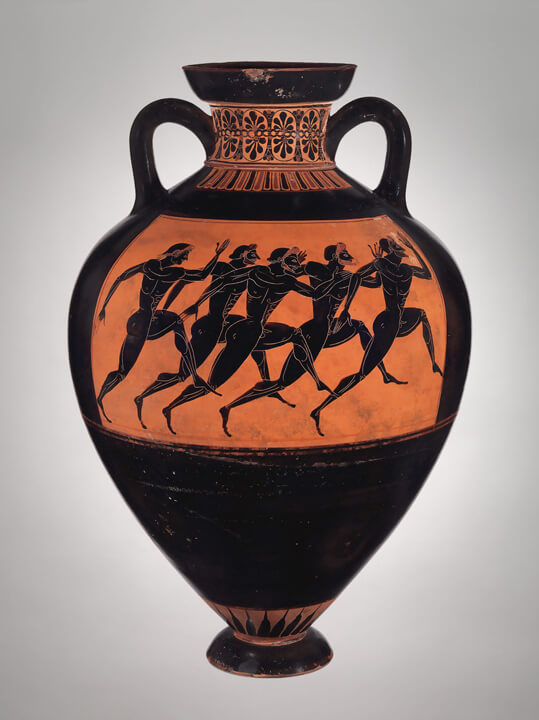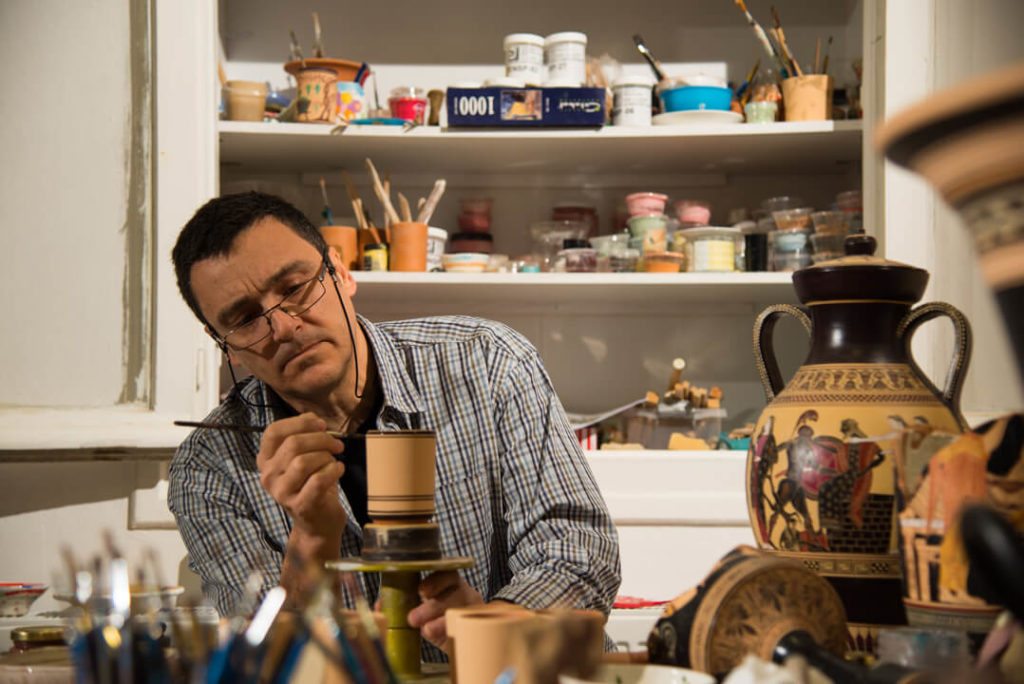Pottery was ubiquitous in classical antiquity. At a time when metal was expensive, and glass was a luxury out of reach for the majority of households, clay became a cheap and durable material that could be employed for a bewildering variety of purposes. The average ancient Greek household was full of clay pots, jars, containers, and vases. There were clay roof tiles, chimneys, and sewer pipes. Children played with clay toys, women cooked in clay pots, men enjoyed wine out of large clay kraters, and everyone departed this world accompanied by an assortment of humble or elaborate clay funerary artifacts.
The Art of Ceramics in Ancient Greece is an entertaining and informative 14-day study abroad program inspired by the most common archaeological find. Baked clay is almost indestructible since humidity and chemicals in the soil do not affect it. Painted ceramics range in quality from commonplace and parochial to major works of art, but they all offer valuable clues to the religious beliefs and everyday experiences of ancient societies. After all, in the absence of ancient paintings, depictions on vases constitute an inspiring source of visual material regarding the mythology and religion of ancient Greece.
Thanassis Katsaras, a renowned vase-painter, founder of the Amasis Gallery and Ceramic Studio, will lead a series of ground-breaking workshops in Eleusis, the birthplace of the Eleusinian Mysteries, to reveal the step-by-step process of decorating Greek vases with different types on scenes on different surfaces. Thanassis Katsaras, whose family has worked in ceramics since the early 20th-century, has exhibited internationally, and his demonstrations of painting techniques have attracted widespread attention in the academic world. Some of his replicas of ancient Greek vases, created with the traditional technique, have become valuable additions to the collections of prominent museums in Greece and overseas.
Thanassis Katsaras at his studio (© SAiG)
The pottery capital of antiquity
According to a scholarly account, there are more than 80,000 extant complete vases from Attica alone. Athens became an important center of production when the statesman Solon adopted measures to encourage the export trade of olive oil. Suddenly the local potters were inundated with orders for amphorae. Soon, they found another profitable market in Etruria. The Etruscans were avid consumers of Greek painted vases and imported large quantities from Corinth. But Athenian potters were able to dominate this market with the introduction of the red-figure technique, a technological breakthrough that assured their dominance across the Mediterranean world for a long time.

Terracotta Panathenaic prize amphora, ca. 530 BCE (© The Metropolitan Museum of Art)
The National Archaeological Museum in Athens is the quintessential destination for anyone interested in an introduction to the world of ancient potters and their products. Its collection enables visitors to study the evolution of pottery techniques and styles from the prehistoric period to the end of the ancient world. The Kerameikos Archaeological Museum has an exquisite collection supplied by discoveries in the nearby cemetery, the largest and oldest in classical Athens, Kerameikos. The potters’ quarters (potters=kerameis) were nearby since the flooding of the river Eridanos provided them with exceptional clay to make grave decorations and funerary urns.

Clay into gold
Corinth was the great competitor of Athens, and local potters had the advantage for more than two centuries. They had access to malleable clay that allowed them to produce high-quality vases and small containers with thin walls that proved very popular in overseas markets. Unlike other cities, where the production of vases was considered employment fit only for foreigners, in Corinth it was the citizens who controlled the process and ripped the benefits. They lived a life of luxury, so much so that the tyrant Periander was forced to curtail the extravagant display of wealth with legislative measures. The Romans burned the city and enslaved its citizens, but modern visitors cannot fail to be impressed by the ruins of what used to be ancient Greece’s richest port.
A black figure pyxis & cantharus with a written invocation to the goddess Aphrodite, Archaeological Museum of Ancient Corinth
Where myths are born
Most vases were plain and inexpensive, ideal for everyday use. But there was also a thriving market for more luxurious types of painted pottery. The fine painting of Greek pottery originated in the Minoan period and evolved from simple geometric decorations to a highly stylized vocabulary of motifs (lions, griffins, sphinxes, etc.). Mythology was a rich source of material during the classical period. Vase painters drew inspiration for the stories of their gods and heroes to create masterpieces in clay. Thebes, a city north of Athens, was an important Mycenaean center that was connected with the stories of many mythical figures, including Hercules, Dionysus, Antigone, Oedipus, etc. Their lives provided artists with an inexhaustible source of material that adorns the bodies of countless vases, some of which are preserved at the recently renovated Archaeological Museum of Thebes.

Pottery for the hoi polloi
Aegina was one of the great commercial centers of the ancient world. Pottery production was never particularly impressive on the island, but local sanctuaries have provided us with an impressive array of vases dedicated by pious travelers. The famous temple of Aphaia attracted visitors from all over Greece; the local archaeological museum preserves an interesting collection of pottery that is representative of the types and quality available to the average ancient Greek. After all, most of them did not have the financial means to purchase vases painted by the great artists, so they made do with more affordable versions. Another interesting collection is housed at the Archaeological Museum of Poros. Most of these vases and containers were discovered at the site of the temple of Poseidon, where the famous orator Demosthenes committed suicide to avoid capture by the Macedonians.

If you like what you just read, check this out!

The Art of Ceramics in Ancient Greece – Mentor – Study abroad in Greece
Pottery is one of the most common items to be found in archaeological excavations. The examination of different styles of pottery gives us an interesting view into ancient history.
mentoringreece.com



